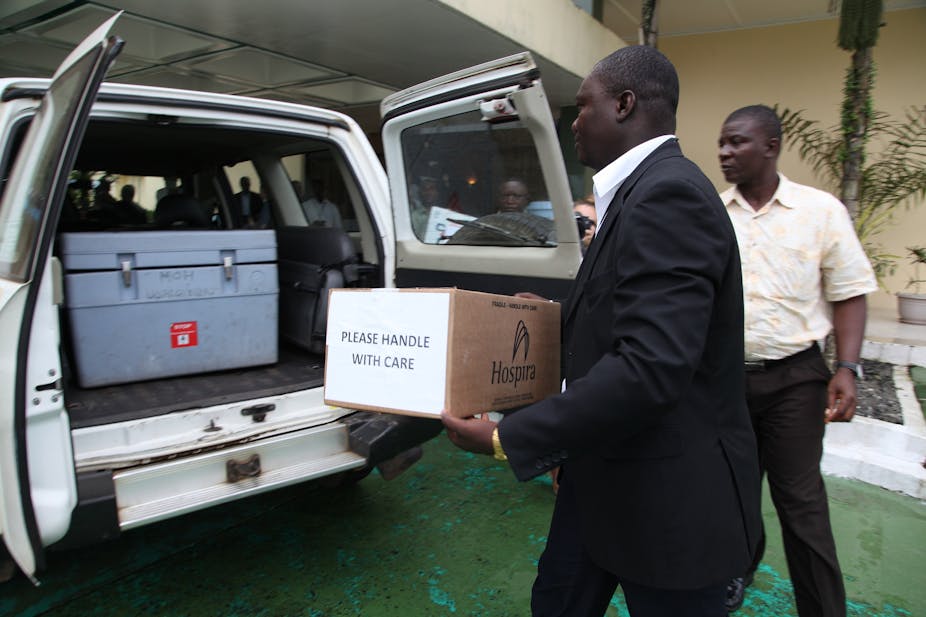The news that at least 20 patients suspected to have Ebola had fled a clinic in Monrovia, Liberia, after a recent protest shows just how volatile trust can be between local populations and medical staff and officials trying to contain the virus.
Any debate over experimental drug use in West Africa is as much tied to this issue as it is to whether deploying them will do anything to stem the outbreak.
Some echoes with early HIV pandemic
Since it was discovered 40 years ago, research into Ebola virus has led to several experimental drug therapies that could be used to treat infection or as a vaccine.
It’s not clear whether the Zmapp drug given to two US doctors and a priest infected with Ebola affected the outcome of infection (both doctors survived, the priest died) but with unsuccessful efforts to bring its spread under control and more than a thousand people already known to have died in Sierra Leone, Liberia and Guinea, and a smaller group in Nigeria, the pressure to deploy them is huge.
Drugs and vaccines are termed experimental for a reason – they have not gone through the normal rigorous testing that is required before a new drug is licensed for use in humans. There’s no objective proof that they are effective, and they may even be harmful, but in extreme situations their deployment may be perfectly justified.
Using drugs in extraordinary circumstances in this way isn’t new – it happened with antiretroviral drugs during the early years of the HIV global pandemic. When HIV first appeared, it had 100% fatality rate. However, the fatality rate of Ebola is lower (around 60%) and in the case of HIV, the drugs had been through significant clinical testing – they were just made available more rapidly than usual. With Ebola, the drugs and treatments being proffered have had only limited testing or no testing in humans at all.
Experimental environment
This raises many difficult ethical, scientific and societal questions. While clinical trials are designed to carefully manage risk and include controls, using experimental drugs against Ebola won’t have the same luxury.
With dangerous viruses such as Ebola, there is also the significant matter of how, practically, to achieve the same efficacy that full licensing of a drug would require in trials. People cannot be deliberately given Ebola in order to try out a drug or vaccine, and we will never know in advance where or when the next outbreak will occur that would create a natural environment for a trial.
Perhaps the best hope is that an experimental treatment shows sufficient promise when deployed in the current outbreak to warrant a government or international organisation funding its small-scale manufacture and stockpiling for use next time Ebola appears.
Managing expectations
Any measures to restrict the spread of Ebola virus need good health infrastructure, trained staff and a system that can deliver a unified response across affected areas if they are to work. Isolating patients, contact follow-ups, breaking the chain of transmission and quarantine, have little to do with science or medicine and far more to do with practicalities on the ground.
Deploying experimental medicine happens within this context, and it carries specific risks that go beyond efficacy. Communicating what is happening and why to individuals and whole communities is vital. The World Health Organisation has already attempted to manage expectations after a recent decision that it was ethical to extend the use of experimental drugs for Ebola:
Recent intense media coverage of experimental medicines and vaccines is creating some unrealistic expectations, especially in an emotional climate of intense fear … The public needs to understand that these medical products are under investigation. They have not yet been tested in humans and are not approved by regulatory authorities, beyond use for compassionate care … For most, administration is difficult and demanding. Safe administration of some requires facilities for intensive care, which are rare in West Africa.
Adverse reactions to treatments can’t be predicted but they regularly happen. And the potential consequences of adverse reactions and/or failure of the drugs to assist may have additional consequences. As well as potential physical damage to patients, a vital but tenuous faith in the medical staff working to control the outbreak could be undermined in West Africa. The protest in Monrovia shows just how precarious trust is.
It might also be undermined if treated patients don’t appear to benefit, even if they are not adversely affected, increasing people’s reluctance to bring infected friends and relatives to medical centres for treatment.
The expected outcomes from using experimental drugs will need to be carefully managed. The number of available doses is very small so however they are deployed, they wouldn’t do much to contain the outbreak. In terms of evidence of efficacy, it also raises the question about whether the number of treatments could ever be sufficient to make any acceptable estimate of how well a drug has worked.
When it comes to any potential vaccines, very limited doses raises the question of how recipients would be chosen, since vaccines have to be given to people who aren’t yet ill. Perhaps the greatest impact on the course of the outbreak would come from protecting those tasked with caring the infected but of course, with many overseas medical staff, this might invite criticism that they were being treated more favourably.
Alongside all this it’s important to carry on with more traditional clinical trials. Criticism of big pharma for not producing an effective remedy for Ebola over the past 40 years has been overly simplistic. Taking a new drug or vaccine to market may cost up to US$1 billion. It’s not simply a matter of there being insufficient profit in developing drugs to treat Ebola – there would actually be a huge loss. But given this is the longest and largest outbreak yet recorded, let’s hope there is new impetus to push forward in this area.

